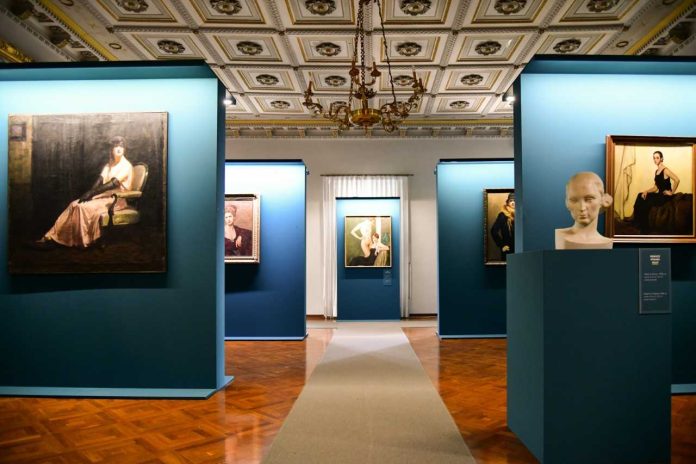by InTrieste
This week marked the grand opening of the exhibition “Eternal Feminine: Art in Trieste Between Fascination and Discretion 1900-1940” at the Civic Museum Sartorio, located on Largo Papa Giovanni XXIII.
The event was graced by the presence of Culture Councillor Giorgio Rossi, Stefano Bianchi, the Head of Historical and Artistic Museums for the Municipality of Trieste, Michela Messina, the curator of the Sartorio Museum, and the exhibition curators Alessandra Tiddia and Federica Luser.
Organized by the Department for Cultural and Tourism Policies, Tourist Promotion Service, Museums, Cultural Events, and Sports, in collaboration with Trart Cooperative Society for Cultural Services, the exhibition showcases around thirty portraits of Triestine women from the early decades of the 1900s.
“This morning, we unveil this splendid exhibition at the Sartorio Museum – ‘Eternal Feminine: Art in Trieste Between Fascination and Discretion 1900-1940.’ Alongside Councillor Giorgio Rossi, we have lost count of the number of inaugurated displays in recent days,” remarked Stefano Bianchi, the Head of Historical and Artistic Museums for the Municipality of Trieste. “This exhibition is the result of a collaborative effort that began last year with Trart Cooperative Society for Cultural Services, curated by Alessandra Tiddia, Federica Luser, and Michela Messina. Following the same vein as last year’s exhibition on Marussig, this year, we’ve brought together civic collections with significant private collections, including the invaluable sponsorship of the CRTrieste Foundation, and several anonymous lenders to create this exhibition.”
The paintings are sourced from the collections of the Sartorio Museum, the Revoltella Museum, and private collections in Trieste, including the art collection of the CRTrieste Foundation. The aim is to provide a unique perspective on Trieste through works by some of its finest artists of the century.
Giorgio Rossi, the Culture Councillor, stated, “The title given to the exhibition, ‘Eternal Feminine: Art in Trieste Between Fascination and Discretion 1900-1940,’ is apt because, in addition to describing two characteristics of feminine beauty, particularly that of Triestine women, it also describes two characteristics of our city – charming and discreet, never vulgar. The year 2023 has been one of great achievements for us, and 2024 will undoubtedly be even better. The incredible increase in visitors is due to the significant and important work done in recent years. We will strive to maintain the significant recognition that Il Sole 24 Ore has given us, placing us at the forefront in Italy for culture and leisure. We must make culture our winning weapon.”
The exhibition focuses on the feminine world, capturing the eternal feminine. It emphasizes Triestine women whose gazes, poses, and gestures reflect their characteristic of discreet yet determined charm, linked to their independence and self-assuredness. The subjects range from muses, friends, wives, lovers, to beautiful and bold women, provocative and content, shy and reserved – mirrors of Trieste at that time. It portrays a discreet, enigmatic, and sometimes ambiguous charm, captured in the social life and the secrecy of rooms.
The selected works for this exhibition are by artists such as Franco Asco, Antonio Camaur, Glauco Cambon, Bruno Croatto, Cesare Cuccoli, Oscar Hermann Lamb, Mario Lannes, Pietro Lucano, Giannino Marchig, Piero Marussig, Giovanni Mayer, Argio Orell, Gino Parin, Nino Poliaghi, Arturo Rietti, Ruggero Rovan, Edgardo Sambo, Carlo Sbisà, Cesare Sofianopulo, Vito Timmel, and Carlo Wostry.
The artworks span the first four decades of the 20th century, a period of significant change and upheaval, suspended between euphoria and drama due to the epochal transformations of a city that, after World War I, witnessed its world crumble and then rebuild in different forms and manners. The artistic sensibilities and expressive languages are diverse, oscillating between symbolist and post-impressionist references and the atmospheres associated with Art Deco and Magical Realism.
What unites these depictions of femininity, the common thread among the selected works, is the subtle, sometimes hidden, sometimes more apparent equation between these figures and Trieste – that discreet and disturbing charm, that “cantankerous grace” that surfaces in poses, facial expressions, and the relationship between the portrayed and the context, often conveyed through a detail or narrated in the space of the canvas. It reflects the image of a subtle essence, that of a controversial city: Trieste, indeed.
In the splendid halls of the Sartorio Museum, sculpture and painting intertwine, creating an ideal setting for showcasing these masterpieces of the Triestine school, where they are imaginatively restored to the atmosphere for which they were conceived within the interiors of a historic residence. The exhibition will remain open until April 1, 2024.





























